Shift Arithmetic - Shift bits or binary point of
signal - Simulink ([original](http://www.mathworks.com/help/simulink/slref/shiftarithmetic.html)) ([raw](?raw))Shift bits or binary point of signal
Libraries:
Simulink / Logic and Bit Operations
HDL Coder / Logic and Bit Operations
Description
The Shift Arithmetic block can shift the bits or the binary point of an input signal, or both.
For example, shifting the binary point on an input of data type sfix(8) by two places to the right and left gives these decimal values.
| Shift Operation | Binary Value | Decimal Value |
|---|---|---|
| No shift (original number) | 11001.011 | –6.625 |
| Binary point shift right by two places | 1100101.1 | –26.5 |
| Binary point shift left by two places | 110.01011 | –1.65625 |
This block performs arithmetic bit shifts on signed numbers. Therefore, the block recycles the most significant bit for each bit shift. Shifting the bits on an input of data typesfix(8) by two places to the right and left gives these decimal values.
| Shift Operation | Binary Value | Decimal Value |
|---|---|---|
| No shift (original number) | 11001.011 | –6.625 |
| Bit shift right by two places | 11110.010 | –1.75 |
| Bit shift left by two places | 00101.100 | 5.5 |
Examples
This example shows the effect of binary point shifts.
model='ex_shift_arithmetic_block_binary_point_shifts'; open_system(model)
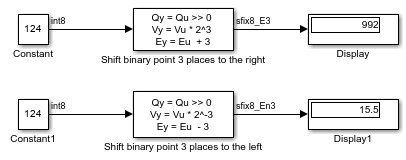
This example shows a comparison of the behavior of right bit shifts using the dialog box versus the block input port.
model='ex_shift_arithmetic_block_right_bit_shifts'; open_system(model)
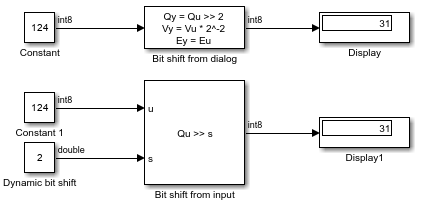
Ports
Input
Number to be operated on, specified as a scalar, vector, or array.
Data Types: single | double | half | int8 | int16 | int32 | int64 | uint8 | uint16 | uint32 | uint64 | fixed point
Number of bits to shift, specified as a scalar.
Data Types: single | double | half | int8 | int16 | int32 | int64 | uint8 | uint16 | uint32 | uint64 | fixed point
Output
Result of operation, returned as a scalar, vector, or array.
Data Types: single | double | half | int8 | int16 | int32 | int64 | uint8 | uint16 | uint32 | uint64 | fixed point
Parameters
Specify whether to enter the bits to shift on the dialog box or to inherit the values from an input port.
Tunable: No
Programmatic Use
| Block Parameter:BitShiftNumberSource |
|---|
| Type: character vector, string |
| Values:'Dialog' | 'Input port' |
| Default:'Dialog' |
Specify the direction in which to shift bits: left, right, or bidirectional.
Tunable: No
Programmatic Use
| Block Parameter:BitShiftDirection | |
|---|---|
| Type: character vector, string | |
| Values: 'Left' |'Right' | 'Bidirectional' |
| Default: 'Bidirectional' |
Specify a scalar, vector, or array of bit shift values.
| If the direction is... | Then... |
|---|---|
| Left orRight | Use positive integers to specify bit shifts. |
| Bidirectional | Use positive integers for right shifts and negative integers for left shifts. |
Tunable: No
Dependencies
To enable this parameter, set Bits to shift: Source to Dialog.
Programmatic Use
| Block Parameter:BitShiftNumber | |
|---|---|
| Type: character vector, string | |
| Values: scalar | vector | array |
| Default: '8' |
Specify an integer number of places to shift the binary point of the input signal. A positive value indicates a right shift, while a negative value indicates a left shift.
Tunable: No
Programmatic Use
| Block Parameter:BinPtShiftNumber |
|---|
| Type: character vector, string |
| Values: scalar |
| Default: '0' |
Specify whether to produce a warning or error during simulation when the block contains an out-of-range shift value. Options include:
None— The software takes no action.Warning— The software displays a warning and continues the simulation.Error— The software terminates the simulation and displays an error.
For more information, see Simulation and Accelerator Mode Results for Out-of-Range Bit Shift Values.
Programmatic Use
| Block Parameter:DiagnosticForOORShift | |
|---|---|
| Type: character vector, string | |
| Values: 'None' |'Warning' | 'Error' |
| Default:'None' |
Select this check box to include conditional statements in the generated code that protect against out-of-range bit shift values. This check box is available when Bits to shift: Source isInput port.
For more information, see Code Generation for Out-of-Range Bit Shift Values.
Programmatic Use
| Block Parameter:CheckOORBitShift |
|---|
| Type: character vector, string |
| Values: 'on' |'off' |
| Default:'off' |
Block Characteristics
| Data Types | double | fixed point | half | integer | single |
|---|---|---|---|---|
| Direct Feedthrough | yes | |||
| Multidimensional Signals | no | |||
| Variable-Size Signals | no | |||
| Zero-Crossing Detection | no |
More About
The Shift Arithmetic block icon shows the block behavior using these variables:
Q— Stored integer valueV— Real world valueE— ExponentQy— Stored integer value of outputQu— Stored integer value of inputVy— Value of outputVu— Value of inputEy— Exponent of outputEu— Exponent of input
The Behavior of Right Bit Shifts example compares the behavior of right bit shifts using the dialog box versus the block input port.
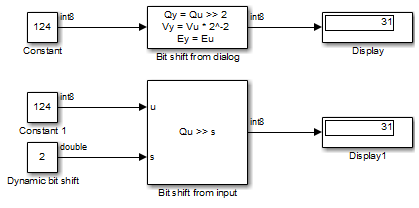
The key block parameter settings of the Constant blocks are:
| Block | Parameter | Setting |
|---|---|---|
| Constant and Constant1 | Constant value | 124 |
| Output data type | int8 | |
| Dynamic bit shift | Constant value | 2 |
| Output data type | Inherit: Inherit from 'Constant value' |
The key block parameter settings of the Shift Arithmetic blocks are:
| Block | Parameter | Setting |
|---|---|---|
| Bit shift from dialog | Bits to shift: Source | Dialog |
| Bits to shift: Direction | Right | |
| Bits to shift: Number | 2 | |
| Bit shift from input | Bits to shift: Source | Input port |
| Bits to shift: Direction | Right |
The top Shift Arithmetic block takes an input of 124, which corresponds to 01111100 in binary format. Shifting the number of bits two places to the right produces 00011111 in binary format. Therefore, the block outputs 31.
The bottom Shift Arithmetic block performs the same operation as the top block. However, the bottom block receives the bit shift value through an input port instead of the dialog box. By supplying this value as an input signal, you can change the number of bits to shift during simulation.
The Effect of Binary Point Shifts example shows the effect of binary point shifts.
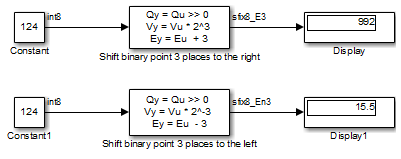
The key block parameter settings of the Constant blocks are:
| Block | Parameter | Setting |
|---|---|---|
| Constant and Constant1 | Constant value | 124 |
| Output data type | int8 |
The key block parameter settings of the Shift Arithmetic blocks are:
| Block | Parameter | Setting |
|---|---|---|
| Shift binary point 3 places to the right | Bits to shift: Source | Dialog |
| Bits to shift: Direction | Bidirectional | |
| Bits to shift: Number | 0 | |
| Binary points to shift: Number | 3 | |
| Shift binary point 3 places to the left | Bits to shift: Source | Dialog |
| Bits to shift: Direction | Bidirectional | |
| Bits to shift: Number | 0 | |
| Binary points to shift: Number | – 3 |
The top Shift Arithmetic block takes an input of 124, which corresponds to 01111100 in binary format. Shifting the binary point three places to the right produces 01111100000 in binary format. Therefore, the top block outputs 995.
The bottom Shift Arithmetic block also takes an input of 124. Shifting the binary point three places to the left produces 01111.100 in binary format. Therefore, the bottom block outputs 15.5.
Algorithms
Suppose that WL is the input word length. The shaded regions in the following diagram show out-of-range bit shift values for left and right shifts.
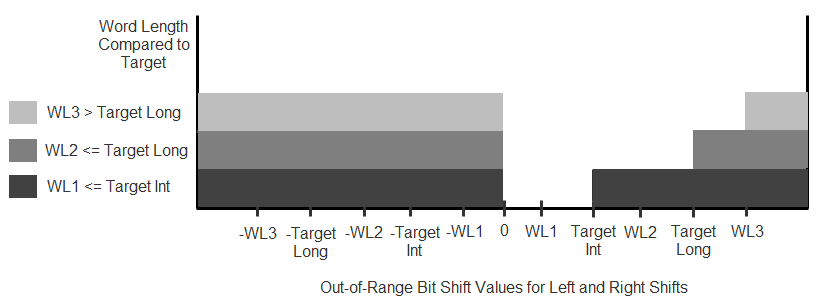
Similarly, the shaded regions in the following diagram show out-of-range bit shift values for bidirectional shifts.
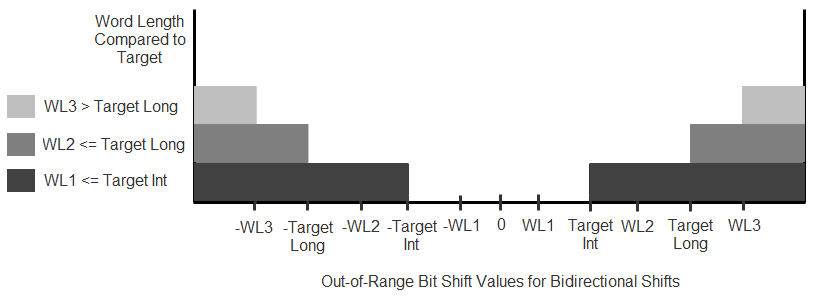
The diagnostic for out-of-range bit shifts responds as follows, depending on the mode of operation:
| Mode | Diagnostic for out-of-range shift value | ||
|---|---|---|---|
| None | Warning | Error | |
| Simulation modes | Do not report any warning or error. | Report a warning but continue simulation. | Report an error and stop simulation. |
| Code generation | Has no effect. |
Suppose that U is the input, WL is the input word length, and Y is the output. The output for an out-of-range bit shift value for left shifts is as follows:
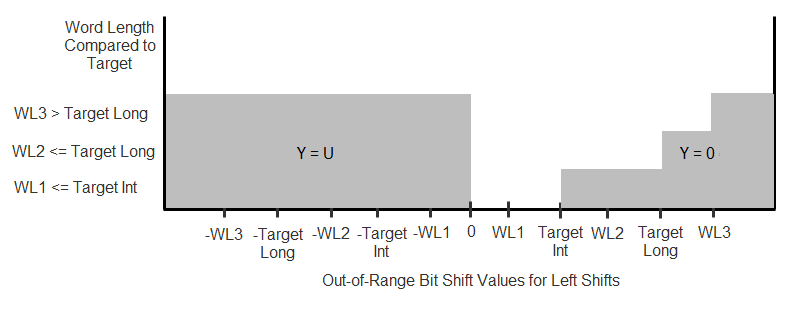
Similarly, the output for an out-of-range bit shift value for right shifts is as follows:
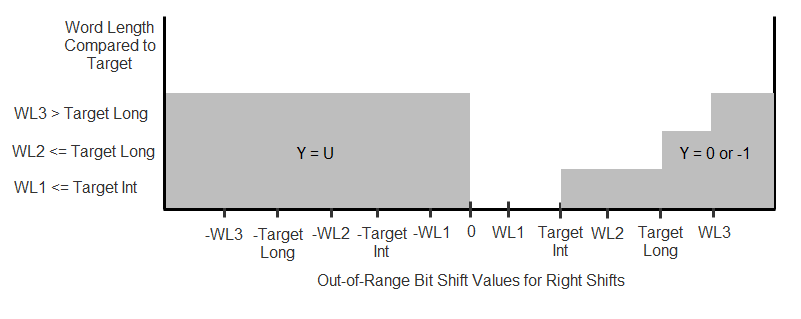
For bidirectional shifts, the output for an out-of-range bit shift value is as follows:
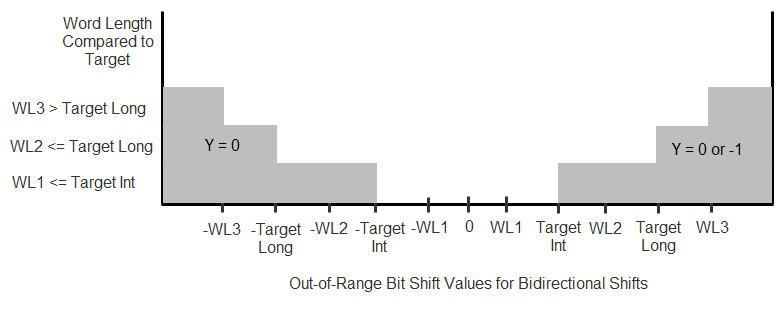
For generated code, the method for handling out-of-range bit shifts depends on the setting of Check for out-of-range 'Bits to shift' in generated code.
| Check Box Setting | Generated Code | Simulation Results Compared to Generated Code |
|---|---|---|
| Selected | Includes conditional statements to protect against out-of-range bit shift values. | Simulation and Accelerator mode results match those of code generation. |
| Cleared | Does not protect against out-of-range bit shift values. | For in-range values, simulation and Accelerator mode results match those of code generation.For out-of-range values, the code generation results are compiler specific. |
For right shifts on signed negative inputs, most C compilers use an arithmetic shift instead of a logical shift. Generated code for the Shift Arithmetic block depends on this compiler behavior.
Extended Capabilities
HDL Coder™ provides additional configuration options that affect HDL implementation and synthesized logic.
You can generate HDL code when Bits to shift: Source isDialog or Input port.
HDL Architecture
The generated VHDL code uses the shift_right function andsll operator.
The generated Verilog code uses the >>> and<<< shift operators.
HDL Block Properties
| ConstrainedOutputPipeline | Number of registers to place at the outputs by moving existing delays within your design. Distributed pipelining does not redistribute these registers. The default is0. For more details, see ConstrainedOutputPipeline (HDL Coder). |
|---|---|
| InputPipeline | Number of input pipeline stages to insert in the generated code. Distributed pipelining and constrained output pipelining can move these registers. The default is0. For more details, see InputPipeline (HDL Coder). |
| OutputPipeline | Number of output pipeline stages to insert in the generated code. Distributed pipelining and constrained output pipelining can move these registers. The default is0. For more details, see OutputPipeline (HDL Coder). |
Complex Data Support
This block supports code generation for complex signals.
Restrictions
When Bits to shift: Source is Input port, binary point shifting is not supported.
Version History
Introduced before R2006a